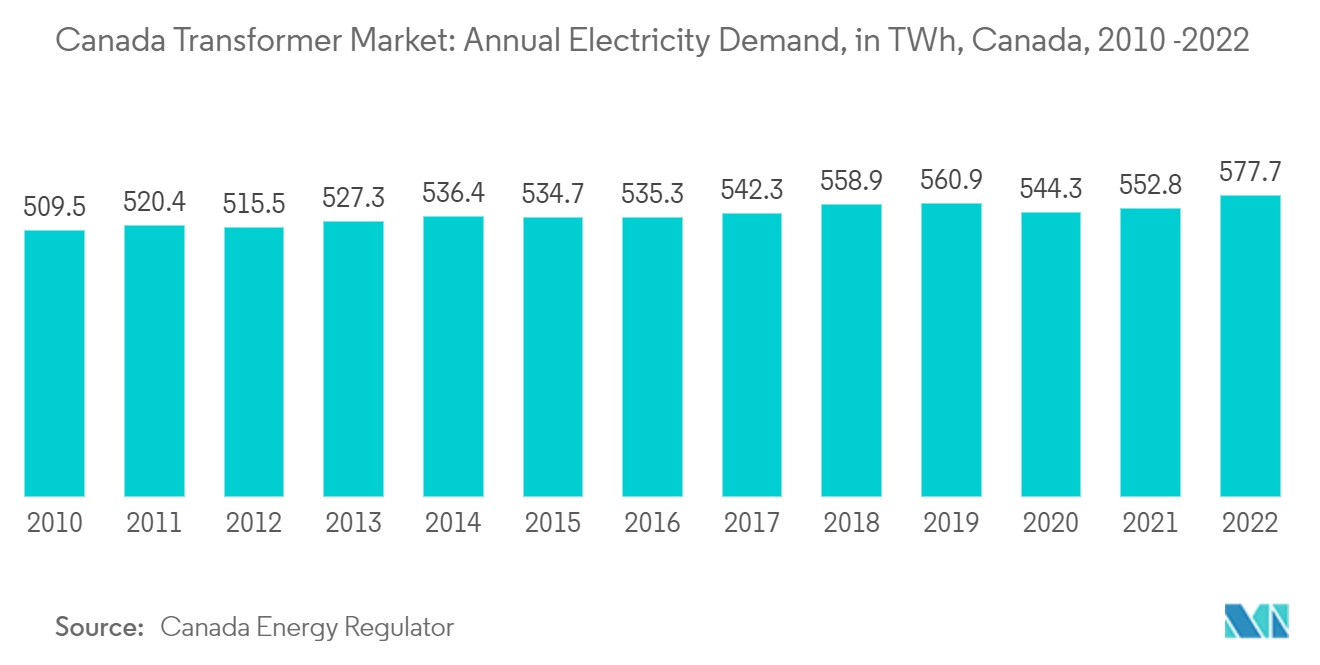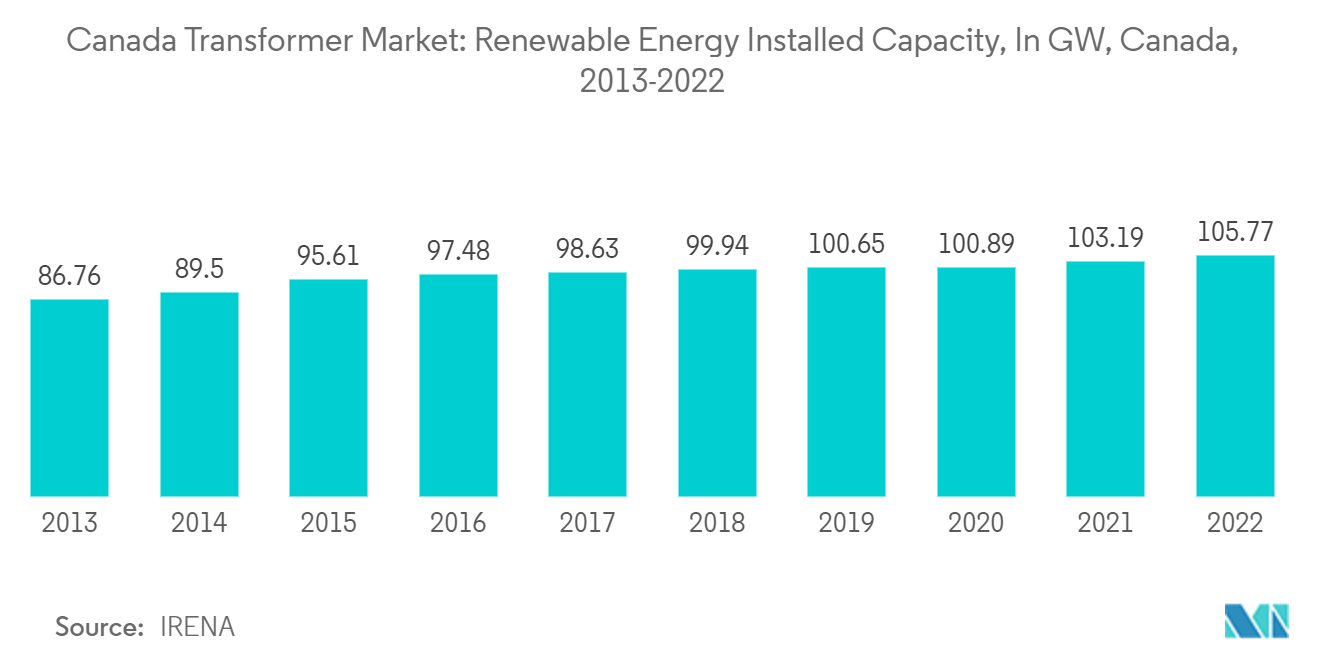Market Trends of Canada Transformer Industry
Distribution Transformers is Expected to Witness Significant Growth
- A distribution transformer alters the high voltage to a normal voltage, like 240/120 V, for electric power distribution. In the distribution system, there are different kinds of transformers available, including single-phase, 3-phase, underground, pad-mounted, and pole-mounted transformers. Generally, these transformers are available in various sizes and efficiencies along with insulating oil.
- Distribution transformers with voltage distribution less than 33 kV are used in industries, while 380V/220V DTs are used for domestic purposes. DTs are used for commercial and industrial applications to step down power from distribution voltage, to be used in HVAC or process loads (220V or 480V), or to serve plug loads (120V).
- Distribution transformers are found in almost every commercial building and industrial facility. Commercial buildings and industrial facilities, with an overall load >0.5 MW, are likely to have one or more medium-voltage distribution transformers, while smaller buildings may have only low-voltage equipment.
- Canada's power infrastructure is a complex network of power generation facilities, transmission lines, and distribution networks that work together to deliver electricity to Canadians.
- As the demand for electricity continues to grow and the power grid evolves, investments in advanced grid infrastructure and renewable energy sources will play a crucial role in the distribution transformers market.
- According to Statistics Canada, in 2022, the electricity generated in the country reached 640 TWh, which witnessed an increase of about 2% from around 627 TWh in 2021. Similarly, the electricity demand has reached 577.7 TWh in 2022, with a growth rate of about 4.5% from 552.80 TWh in 2021. This is expected to increase further over the forecast period.
- Canada has been experiencing increased electricity generation from renewable power sources in recent years. In 2022, the country generated a total of electricity from renewable power sources, with a share of around 69%. Further, the country aims to have 90% of the electricity come from clean energy sources such as hydro, wind, and solar by 2030, which is expected to witness a massive growth in the renewable power sources integrating into the power grid and upgrading the electricity infrastructure in the country. This is anticipated to create a vast demand for distribution transformers in the coming years.
- Further, Canada is also expected to hold decent opportunities for distribution transformers in upgrading and replacing aging power infrastructure. For instance, in December 2022, Enmax Power Corporation is beginning the two-year process of replacing Calgary's first substation. The station powers about half of Calgary's downtown, and the new CAD 200-million replacement substation is being built just across the street. According to the utility, this project will be the biggest in its history, including a new 35,000-square-foot (3,250-square-metre) building with six high-voltage transmission lines and 24 medium-voltage network feeder lines. Such upgrade or modernization projects are expected to have a notable opportunity for electrical equipment like transformers.
- Hence, as grid networks are becoming more digital, distributed, smart, and increasing, investments in the power transmission and distribution (T&D) sector will, in turn, be expected to culminate the growth of the United States and Canada distribution transformer market during the forecast period.

Increasing Deployment of Renewable Energy to Drive the Market
- The transformer market in Canada has experienced a transformative shift in recent years, largely driven by the imperative to integrate renewable energy sources into the electrical grid. As the global focus on sustainable energy solutions intensifies, both nations have committed to reducing their carbon footprint and embracing cleaner energy alternatives.
- This transition to renewable energy, characterized by the adoption of wind, solar, and hydropower generation, has not only necessitated substantial changes in the power generation landscape but has also profoundly impacted the infrastructure.
- According to the International Renewable Energy Agency, renewable energy installation in Canada has increased since 2013. In 2022, the installed renewable energy capacity in Canada was 105.77 GW compared to 103.19 GW in 2021, registering a growth rate of over 2.5% between 2021 and 2022, while the annual growth rate in the last decade was over 2%.
- Canada is also expected to replace older grid infrastructure, including transformers, and add transmission and distribution (T&D) lines to increase the electrification rates to meet the electricity demand in rural areas. The country is also witnessing a notable initiative from the federal government to help rural and remote communities adopt clean energy. For instance, in April 2022, the Canadian government announced USD 230.64 million in funding to support the communities by launching clean energy projects such as wind, solar, geothermal, hydro, and others, along with a new, streamlined service model for communities who seek to access resources and clean energy funding.
- The initiative is a partnership between Natural Resources Canada (NRCan), Crown-Indigenous Relations and Northern Affairs Canada (CIRNAC), and Indigenous Services Canada (ISC), having support from Infrastructure Canada and Environment and Climate Change Canada. Such efforts will likely boost electrification by increasing the deployment of renewable energy in remote communities, which, in turn, support the growth of transformers in the country.
- Furthermore, the renewable energy sector's growth has prompted technological advancements in transformer design, with manufacturers developing innovative solutions to enhance the compatibility of distribution transformers with intermittent and distributed power generation. These advancements improve electricity transmission efficiency and contribute to grid stability, a critical requirement for accommodating the inherent variability of renewable energy sources.
- For instance, in April 2022, Siemens Energy introduced a pole-mounted dry-type transformer tailored to meet the specific needs of the American grid. This innovative cast-resin distribution transformer offers a dependable, eco-friendly alternative to traditional oil-filled transformers.
- As the adoption of renewable energy sources continues to gain momentum, the demand for transformers that can seamlessly accommodate these transformative changes is expected to remain robust, presenting a compelling market dynamic for manufacturers.


